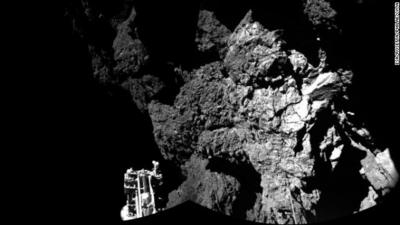Sat, Nov 15, 2014
Spacecraft's Harpoons Did Not Deploy, Now Apparently Lying On Its Side In A Crevice On The Comet's Surface
On Wednesday, Nov. 12, the European Space Agency's Rosetta mission successfully landed on the surface of comet 67P/Churyumov-Gerasimenko. Descending at a speed of about 2 mph the lander, called "Philae," first touched down and its signal was received at 11:03 a.m. EST.

Partially due to anchoring harpoons not firing, and the comet's low gravity (a hundred-thousand times less than that of Earth), Philae bounced off the surface and flew up to about six-tenths of a mile both above the comet's surface as well as downrange. At 12:53 p.m. EST, almost two hours after first contact, Philae again touched down. A second, more modest bounce resulted, again sending it airborne. Philae's third contact with the comet's nucleus was the charm. At 1 p.m. EST, the Rosetta mission's Philae lander became the first spacecraft to soft-land on a comet.
Rosetta mission controllers believe Philae alighted in a hole, or crevice, about six feet in diameter and six feet deep and that it is lying on its side. While the lander remains unanchored to the surface, it remains stable. and eight of its 10 instruments have already begun sending back data. The science team is working on its next moves.
"Philae is on the surface and doing a marvelous job, working very well, and we can say we have a very happy lander," said Paolo Ferri, ESA's head of mission operations at the European Space Operations Center, Darmstadt, Germany.
Teams are still working to confirm the location and the overall power and thermal situation on board. The lander did receive power from some of its solar panels. It appears that some parts of the lander were in shadow during the time that last night's surface telemetry data were being transmitted.
Launched in March 2004, Rosetta was reactivated in January 2014 after a record 957 days in hibernation. The mission consists of an orbiter and lander. Its objectives since arriving at comet 67P/Churyumov-Gerasimenko this summer have been to study the celestial object up close in unprecedented detail, and prepare for Philae's landing. The orbiter will continue tracking the comet's changes as it sweeps past the sun.
(Image provided by ESA)
More News
A Puff Of Smoke Came Out From The Top Of The Engine Cowling Followed By A Total Loss Of Engine Power On May 9, 2025, about 1020 mountain daylight time, an experimental amateur-buil>[...]
From 2022 (YouTube Edition): Jenny, I’ve Got Your Number... Among the magnificent antique aircraft on display at EAA’s AirVenture 2022 was a 1918 Curtiss Jenny painstak>[...]
Very High Frequency (VHF) The frequency band between 30 and 300 MHz. Portions of this band, 108 to 118 MHz, are used for certain NAVAIDs; 118 to 136 MHz are used for civil air/grou>[...]
“From approximately November 2021 through January 2022, Britton-Harr, acting on behalf of AeroVanti, entered into lease-purchase agreements for five Piaggio-manufactured airc>[...]
Microburst A small downburst with outbursts of damaging winds extending 2.5 miles or less. In spite of its small horizontal scale, an intense microburst could induce wind speeds as>[...]
 NTSB Prelim: Lee Aviation LLC JA30 SuperStol
NTSB Prelim: Lee Aviation LLC JA30 SuperStol Classic Aero-TV: Curtiss Jenny Build Wows AirVenture Crowds
Classic Aero-TV: Curtiss Jenny Build Wows AirVenture Crowds ANN's Daily Aero-Term (05.30.25): Very High Frequency (VHF)
ANN's Daily Aero-Term (05.30.25): Very High Frequency (VHF) Aero-News: Quote of the Day (05.30.25)
Aero-News: Quote of the Day (05.30.25) ANN's Daily Aero-Term (05.31.25): Microburst
ANN's Daily Aero-Term (05.31.25): Microburst



